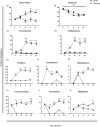Antibiotic Cocktail: An Excellent Tool to Probe Physiology by Perturbing Gut Microbiota: A Mice Model
- PMID: 40817939
- PMCID: PMC12357809
- DOI: 10.1007/s00284-025-04409-5
Antibiotic Cocktail: An Excellent Tool to Probe Physiology by Perturbing Gut Microbiota: A Mice Model
Abstract
Antibiotics have become an excellent tool for understanding the role of gut microbes. While the effect of antibiotic treatment on adults is studied, its impact during adolescence is unclear. In the current study, we treated C57BL/6 mice with an antibiotic cocktail composed of nine antibiotics from weaning (3 weeks old) until they became young adults (10 weeks old). We investigated the effect of antibiotic treatment (1) on gut microbiota composition, (2) on the brain by studying the behavior, Hypothalamic-Pituitary-Adrenal (HPA axis), neuroinflammation, neurotransmitters, neuronal health, and appetite regulators, and (3) on systemic circulation by recording changes in the stress hormones, insulin resistance, and metabolic profile. In the gut, we found that the antibiotic treatment significantly increased the Proteobacteria and Actinobacteria while decreasing the Bacteroidetes phylum. In the brain, we observed HPA axis activation, elevated proinflammatory response, decline in neurotrophins, neurotransmitter abundance, and appetite regulators expression, which could be linked with behavioral changes. We found increased insulin resistance and altered metabolite profiles in the peripheral system. Moreover, our association study highlights the role of Proteobacteria and Actinobacteria in altering the host behavior, brain function, and systemic circulation. Altogether this study demonstrates, how prolonged antibiotic exposure during adolescence disrupts gut microbiota and is associated with physiological and behavioral alterations through gut peripheral system and brain interactions.
© 2025. The Author(s).
Conflict of interest statement
Declarations. Conflict of interest: The authors have no conflicts of interest to declare. Ethical Approval: The protocol used for animal studies has been approved by the Institutional Animal Ethical Committee (IAEC)-NISER, Bhubaneswar, India (NISER/SBS/AH-204). This paper doesn’t contain any human experiment.
Figures





Similar articles
-
Prescription of Controlled Substances: Benefits and Risks.2025 Jul 6. In: StatPearls [Internet]. Treasure Island (FL): StatPearls Publishing; 2025 Jan–. 2025 Jul 6. In: StatPearls [Internet]. Treasure Island (FL): StatPearls Publishing; 2025 Jan–. PMID: 30726003 Free Books & Documents.
-
Intestinal inflammation and microbiota modulation impact cochlear function: emerging insights in gut-ear axis.Cell Commun Signal. 2025 Jul 26;23(1):357. doi: 10.1186/s12964-025-02338-1. Cell Commun Signal. 2025. PMID: 40713718 Free PMC article.
-
Differential modulation of post-antibiotic colonization resistance to Clostridioides difficile by two probiotic Lactobacillus strains.mBio. 2025 Aug 13;16(8):e0146825. doi: 10.1128/mbio.01468-25. Epub 2025 Jul 21. mBio. 2025. PMID: 40689613 Free PMC article.
-
The Black Book of Psychotropic Dosing and Monitoring.Psychopharmacol Bull. 2024 Jul 8;54(3):8-59. Psychopharmacol Bull. 2024. PMID: 38993656 Free PMC article. Review.
-
Synbiotics, prebiotics and probiotics for solid organ transplant recipients.Cochrane Database Syst Rev. 2022 Sep 20;9(9):CD014804. doi: 10.1002/14651858.CD014804.pub2. Cochrane Database Syst Rev. 2022. PMID: 36126902 Free PMC article.
References
-
- Saban Güler M, Arslan S, Ağagündüz D, Cerqua I, Pagano E, Berni Canani R, Capasso R (2025) Butyrate: a potential mediator of obesity and microbiome via different mechanisms of actions. Food Res Int 199:115420. 10.1016/j.foodres.2024.115420 - PubMed
-
- Ağagündüz D, Özata-Uyar G, Kocaadam-Bozkurt B, Özturan-Şirin A, Capasso R, Al-Assaf S, Özoğul F (2023) A comprehensive review on food hydrocolloids as gut modulators in the food matrix and nutrition: the hydrocolloid–gut–health axis. Food Hydrocoll 145:109068. 10.1016/j.foodhyd.2023.109068
LinkOut - more resources
Full Text Sources

